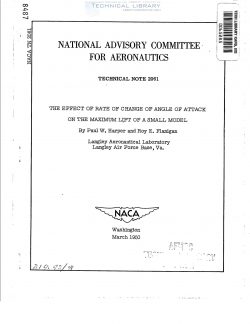naca-tn-2061
- Version
- 87 Downloads
- 861.15 KB File Size
- 1 File Count
- December 9, 2016 Create Date
- December 9, 2016 Last Updated
National Advisory Committee for Aeronautics, Technical Notes - The Effect of Rate of Change of Angle of Attack on the Maximum Lift of a Small Model

A wind—tunnel investigation was conducted of a scale partial
model of a conventional fighter airplane to determine the effects of
rate of change of angle of attack on its maximum.lift. The tests were
intended to supplement previous tests of the same model by extending the
range of variables. The present tests covered a Mach number range from
approximately 0.10 to 0.80 at pitching velocities varying from.nearly 0
to about 20 radians per second.
The results showed that the maximum.lift coefficient increased
linearly with pitching velocity up to a limit value of the lift coeffi—
cient which depended on the mach number. The magnitude of the pitching—
velocity effect on the maximum lift coefficient decreased with increasing
Mach number so that it became negligible for a Mach number of about 0.60.
The rate of change of angle of attack has in recent years assumed
appreciable significance among the parameters affecting the maximum.wing
loads and therefore the maneuverability of high—speed aircraft and
missiles. Since the dynandc nature of this parameter has precluded
investigations of its effect by the usual wind—tunnel—test procedures,
a technique has been employed whereby a model was made to rotate in a
manner simulating the motion of an airplane during pullrups of varying
abruptness. Results of a wind—tunnel investigation using this technique
on a §%-scale model of a conventional fighter airplane were presented
in reference 1 for a Mach number range from about 0.20 to 0.60 with
pitching velocities varying from about 3 to 12 radians per second and
compared with flight results for the same airplane.
The satisfactory agreement obtained in the comparison indicated
that model results could be used to predict maximum.lift for full—scale
flight conditions and, therefore, prompted further tests on the same
model over extended ranges of pitching velocity and Mach number primarily
to determine a limiting value of the maximum.lift coefficient, the extent
of the maximmnbflift—coefficient increment above the value for steady con—
ditions, and the Mach number range in which pitching velocity is effective
in increasing the maximum.lift. An investigation was therefore conducted
in the Langley high—speed 7e-by 10—foot tunnel over a Mach number range
from about 0.10 to 0.80 and over a pitchingryelocity range from nearly 0
to about 20 radians per second. Because of improvements in instrumenta—
tion the results presented herein supersede those given in reference 1.
| File | Action |
|---|---|
| naca-tn-2061 The Effect of Rate of Change of Angle of Attack on the Maximum Lift of a Small Model.pdf | Download |

Comment On This Post